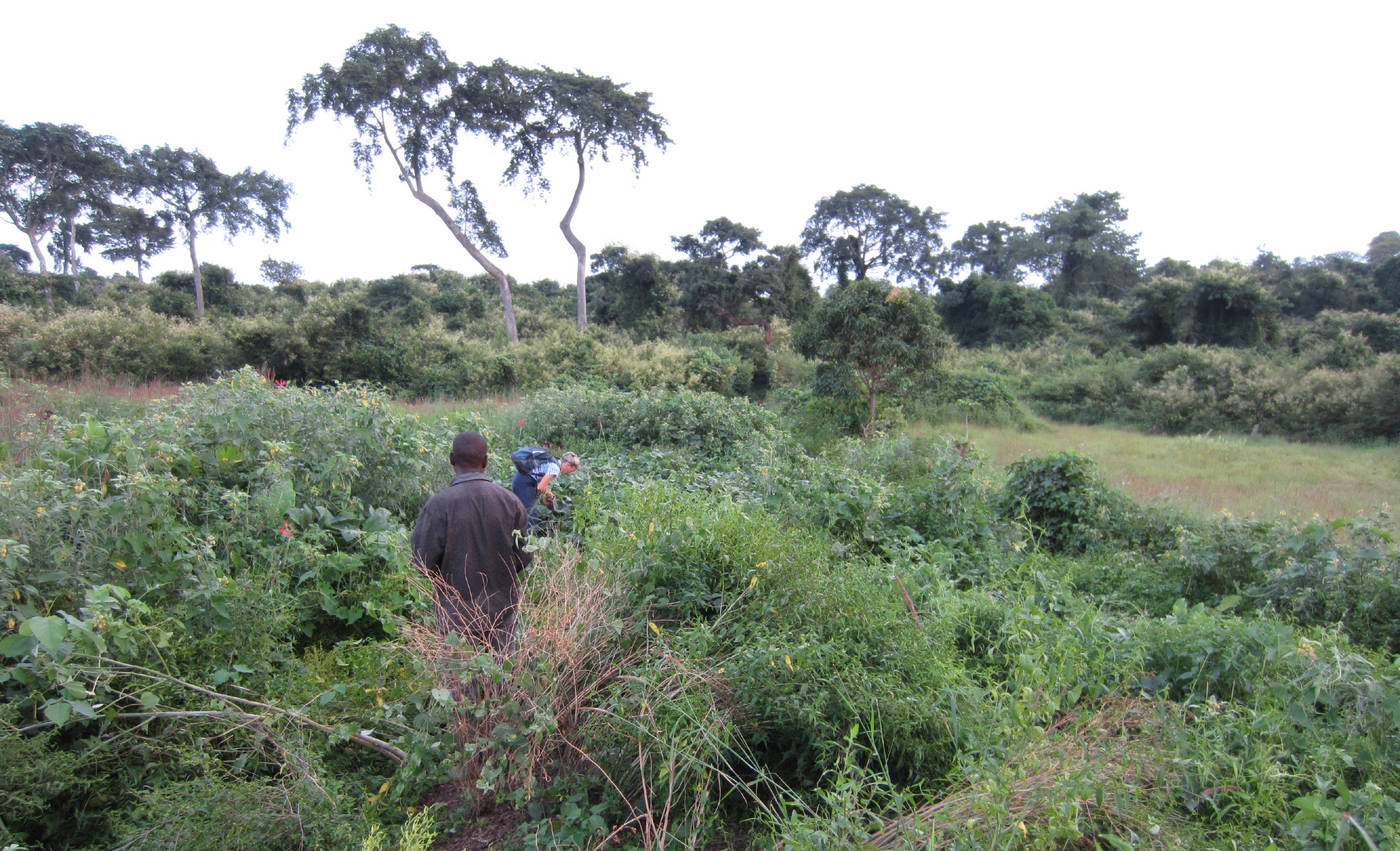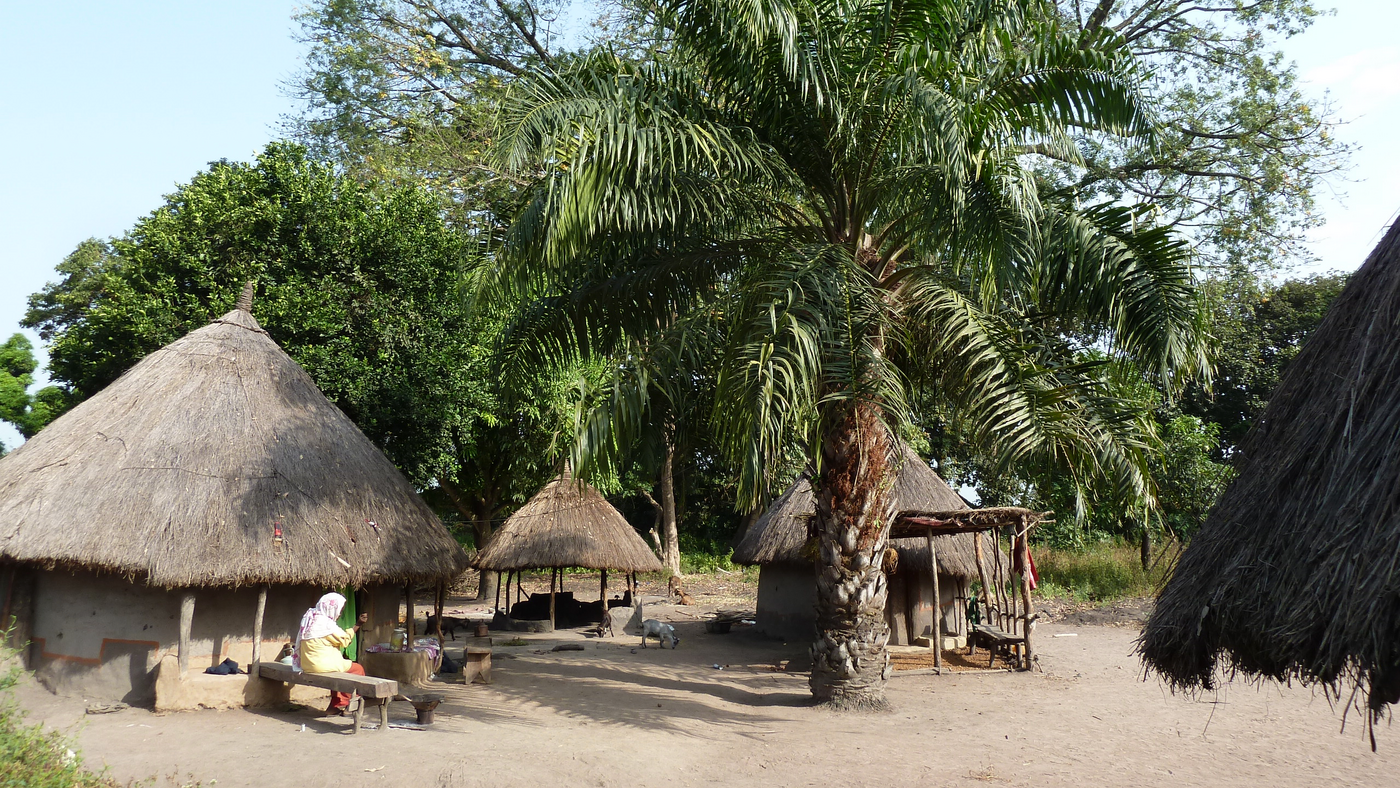Eco-epidemiology
The concept of eco-epidemiology was introduced by a French doctor, Prof. Jean-Antoine Rioux, who was working on leishmaniasis in the eighties. He studied the transmission of Leishmania spp. by looking for spatial, temporal and human risk factors. These are what he called the spatial, temporal and human components of leishmaniasis risk. We can adopt this concept to study the risk of Lassa virus transmission between rodents and humans.
Spatial component
Spatial risk occurs at several scales, regional on the one hand (some 100 km) and local on the other (some 10 km).
- At the regional level, as in Guinea and Sierra Leone, the distribution of the main reservoir, such as M. natalensis, must be investigated. Ecological studies have shown that M. natalensis does not exist on the Guinean coast, its geographical distribution being limited to the west at longitude 12°. The risk of transmission west of 12° is therefore unlikely since the main reservoir does not exist. However, it seems that the virus has recently found a new host such as M. erythroleucus present on the coast. The risk of transmission could then extend to the entire coastal zone if the virus becomes established in this species on a long-term basis.
Another example of expansion is illustrated by the recent Lassa epidemics observed in Benin and Togo in 2014-2018.
- At the local level, it is necessary to investigate in which habitats the reservoir is located. This is done by sampling rodents in houses, surrounding fields, savannah, fallow land, and forest, combined with the testing of all trapped specimens for Lassa virus. Thus, it was shown in Upper Guinea and in Sierra Leone that only M. natalensis living in the houses and surrounding fields were carriers of the virus, whereas in coastal Guinea only M. erythroleucus living in surrounding fields were carriers of the virus. The habitat at risk is therefore the domestic area and the proximal fields in Upper Guinea and in Sierra Leone, and the proximal fields only in Coastal Guinea.


Related key publications
Lassa Virus Circulation in Small Mammal Populations in Bo District, Sierra Leone
- Bangura U, Buanie J, Lamin J, Davis C, Bongo GN, Dawson M, Ansumana R, Sondufu D, Thomson EC, Sahr F, Fichet-Calvet E
- Biology (Basel). 2021 Jan 5;10(1):28. doi: 10.3390/biology10010028
Bridging the gap: Using reservoir ecology and human serosurveys to estimate Lassa virus spillover in West Africa
- Basinski AJ, Fichet-Calvet E, Sjodin AR, Varrelman TJ, Remien CH, Layman NC, Bird BH, Wolking DJ, Monagin C, Ghersi BM, Barry PA, Jarvis MA, Gessler PE, Nuismer SL
- PLoS Comput Biol. 2021 Mar 3;17(3):e1008811. doi: 10.1371/journal.pcbi.1008811
Households as hotspots of Lassa fever? Assessing the spatial distribution of Lassa virus-infected rodents in rural villages of Guinea
- Mariën J, Lo Iacono G, Rieger T, Magassouba N, Günther S, Fichet-Calvet E.
- Emerg Microbes Infect. 2020 Dec;9(1):1055-1064. doi: 10.1080/22221751.2020.1766381.
Movement Patterns of Small Rodents in Lassa Fever-Endemic Villages in Guinea
- Mariën J, Kourouma F, Magassouba N, Leirs H, Fichet-Calvet E.
- Ecohealth. 2018 Jun;15(2):348-359. doi: 10.1007/s10393-018-1331-8
Fluctuation of abundance and Lassa virus prevalence in Mastomys natalensis in Guinea, West Africa
- Fichet-Calvet E, Lecompte E, Koivogui L, Soropogui B, Doré A, Kourouma F, Sylla O, Daffis S, Koulémou K, Ter Meulen J.
- Vector Borne Zoonotic Dis. 2007 Summer;7(2):119-28. doi: 10.1089/vbz.2006.0520
Diversity, dynamics and reproduction in a community of small mammals in Upper Guinea, with emphasis on pygmy mice ecology
- Fichet-Calvet E, Audenaert L, Barriere P & Verheyen E
- African Journal of Ecology, 48: 600-614. Doi:10.1111/j.1365-2028.2009.01144.x
Temporal component
Studies in Sierra Leone and Nigeria suggest that Lassa fever is probably seasonal, occurring more often in the dry season than in the rainy season. Epidemiological data are scarce and some data are contradictory as the pattern is not identical from one year to the next. By studying the dynamics of the reservoir rodents, we will be able to verify whether this hypothesis is valid. Longitudinal study in Guinea, including sampling in the dry season, then at the beginning and end of the rainy season for two years, has shown a seasonal fluctuation in the number of rodents. Indeed, rodents are more numerous inside houses during the dry season than during the rainy season. The high aggregation of rodents during the dry season could explain the higher frequency of Lassa cases. However, they are 2 to 3 times less infected during the dry season. So, if the seasonality hypothesis is correct, it is not due to a higher prevalence within the rodent population, but rather to a higher frequency of contact between rodents and humans.
This frequency is therefore linked to human behaviour, which must be analysed using anthropological and sociological tools.
Related key publications
Small mammal diversity and dynamics within Nigeria, with emphasis on reservoirs of the Lassa virus
- Olayemi A, Obadare A, Oyeyiola A, Fasogbon A, Igbokwe J, Igbahenah F, Orstega D, Günther S, Verheyen E, Fichet-Calvet E
- Systematics and Biodiversity 15, 1-10. doi:10.1080/14772000.2017.1358220
Lassa Virus Seroprevalence in Natural Populations of rodents and Horizontal Transmission
- Fichet-Calvet E, Becker-Ziaja B, Koivogui L, Günther S
- Vector Borne Zoonotic Dis. 2014 Sep;14(9):665-74. doi: 10.1089/vbz.2013.1484
Reproductive characteristics of Mastomys natalensis and Lassa virus prevalence in Guinea, West Africa
- Fichet-Calvet E, Lecompte E, Koivogui L, Daffis S, ter Meulen J
- Vector Borne Zoonotic Dis. 2008 Spring;8(1):41-8. doi: 10.1089/vbz.2007.0118
Fluctuation of abundance and Lassa virus prevalence in Mastomys natalensis in Guinea, West Africa
- Fichet-Calvet E, Lecompte E, Koivogui L, Soropogui B, Doré A, Kourouma F, Sylla O, Daffis S, Koulémou K, Ter Meulen J.
- Vector Borne Zoonotic Dis. 2007 Summer;7(2):119-28. doi: 10.1089/vbz.2006.0520
Human component
- Rodent hunting and consumption. In the nineties, some studies in Forest Guinea have focused on the hunting and consumption of rodents, which could be the source of the contamination. More recently, some qualitative and quantitative methods were developed to provide a fuller and nuanced perspective on human-rodent contact. It seems that this practice is widespread in West Africa. The reasons for rodent consumption are multifactorial, including taste preferences, food security and opportunistic behaviour. It is often carried out by children who take them home as a trophy and a source of animal protein. In some regions such as in Upper Guinea, it is part of the boyish identity during the childhood.
- The dark corners. When farmers are going to the field, they close their houses, leading to the darkness inside. The rodents M. natalensis, which are usually nocturnal when they live outside become diurnal when they live inside. This may represent a higher risk because the animals can deposit infectious urine and feces continuously. There is a high degree of human-rodent interaction at home, and both adults and children have many opportunities to touch rodent-contaminated objects and food.
- Domestic hygiene. Our studies showed that building design and materials provide hiding and nesting places for rodents and lead to close proximity with humans. A quantitative analysis showed that rodent abundance was highly related to the porosity of the habitat. Clearly, houses that are not sealed, with many holes or gaps in the walls, harbour more rodents than well-sealed houses. Other practices such as indoor waste storage are also a risk factor for rodents to enter the house.

To understand why some Lassa foci persist, while others die out or do not exist in a hyperendemic area (spotted distribution), studies on human behaviour need to be expanded. For example, the transport of goods from one village to another, which may move contaminated food or objects, or the alternation of farming activities that alter the time spent at home during the dry or rainy season are still unexplored areas.
Related key publications
Domestic risk factors for increased rodent abundance in a Lassa fever endemic region of rural Upper Guinea
- Clark J, Yakob L, Douno M, Lamine J, Magassouba N', Fichet-Calvet E, Mari-Saez A
- Sci Rep. 2021 Oct 19;11(1):20698. doi: 10.1038/s41598-021-00113-z
Detection of Lassa virus in wild rodent feces: Implications for Lassa fever burden within households in the endemic region of Faranah, Guinea
- Wood R, Bangura U, Mariën J, Douno M, Fichet-Calvet E
- One Health. 2021 Aug 27;13:100317. doi: 10.1016/j.onehlt.2021.100317
Hunting and consumption of rodents by children in the Lassa fever endemic area of Faranah, Guinea
- Douno M, Asampong E, Magassouba N, Fichet-Calvet E, Almudena MS
- PLoS Negl Trop Dis. 2021 Mar 17;15(3):e0009212. doi: 10.1371/journal.pntd.0009212
At Home with Mastomys and Rattus: Human-Rodent Interactions and Potential for Primary Transmission of Lassa Virus in Domestic Spaces
- Bonwitt J, Sáez AM, Lamin J, Ansumana R, Dawson M, Buanie J, Lamin J, Sondufu D, Borchert M, Sahr F, Fichet-Calvet E, Brown H
- Am J Trop Med Hyg. 2017 Apr;96(4):935-943. doi: 10.4269/ajtmh.16-0675
Rat-atouille: A Mixed Method Study to Characterize Rodent Hunting and Consumption in the Context of Lassa Fever
- Bonwitt J, Kelly AH, Ansumana R, Agbla S, Sahr F, Saez AM, Borchert M, Kock R, Fichet-Calvet E
- Ecohealth. 2016 Jun;13(2):234-47. doi: 10.1007/s10393-016-1098-8
Prevalence and risk factors of Lassa seropositivity in inhabitants of the forest region of Guinea: a cross-sectional study
- Kernéis S, Koivogui L, Magassouba N, Koulemou K, Lewis R, Aplogan A, Grais RF, Guerin PJ, Fichet-Calvet E
- PLoS Negl Trop Dis. 2009 Nov 17;3(11):e548. doi: 10.1371/journal.pntd.0000548









